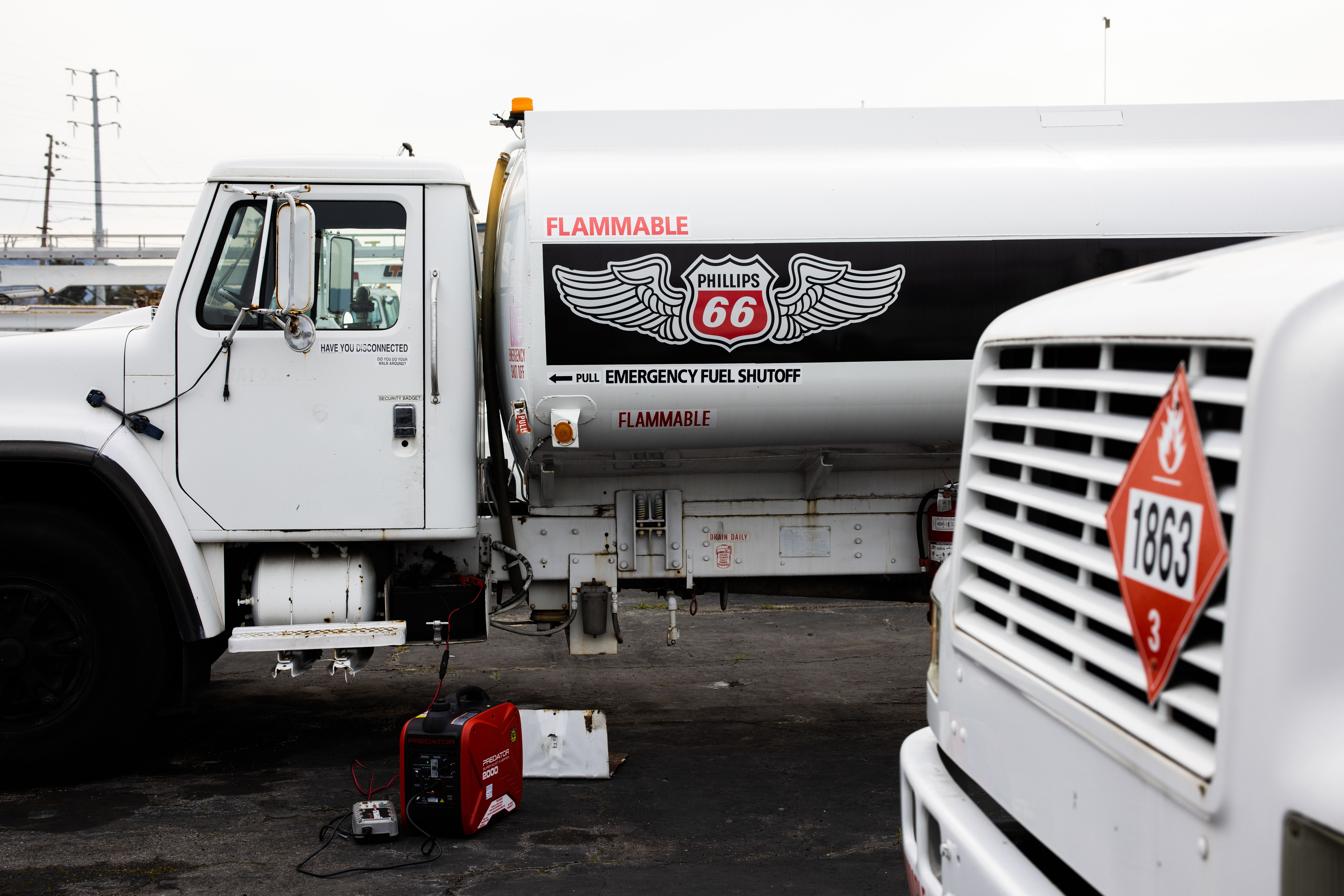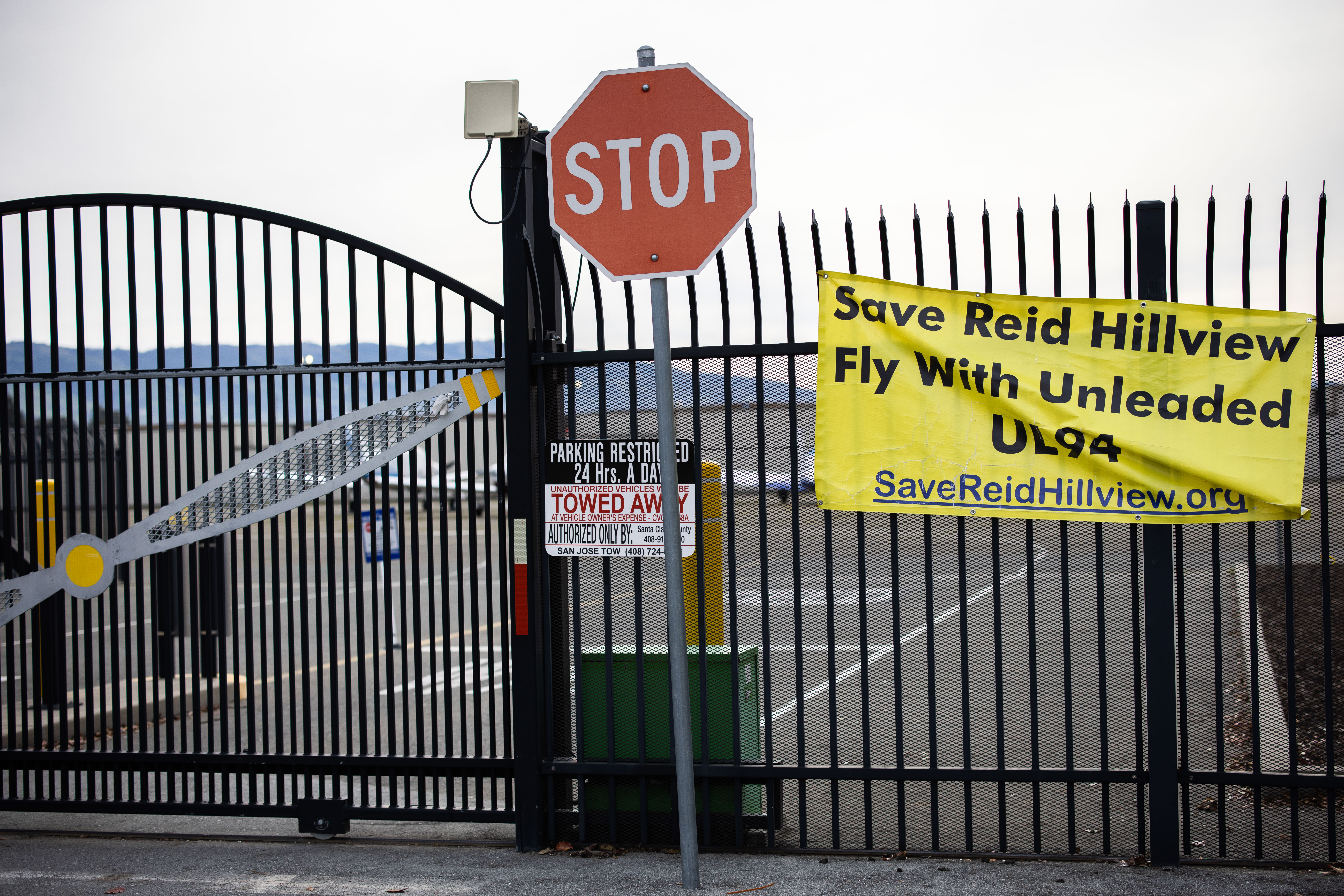‘My kids are being poisoned’: How aviators escaped America’s war on lead
Lead was removed from gasoline decades ago. So why is aviation fuel still laced with the metal — a neurotoxin tied to developmental problems in children?


Veronica Licon and her pediatrician were stumped in 2011 when her son’s blood showed high levels of lead. Her home did not contain the usual culprits for childhood lead poisoning: lead paint or lead pipes.
Paint can be removed. Pipes can be replaced. But Licon lives directly under the flight path to Reid-Hillview Airport in East San Jose, Calif. The small airplanes and choppers flying overhead run on leaded gasoline, dusting her home with a neurotoxin research links to lowered IQ and behavioral problems in children. There’s nothing Licon can do about that.
She’s haunted by the long hours spent at home while pregnant with her youngest daughter, a now 12-year-old girl plagued by learning delays.

Today, toddlers in East San Jose have concentrations of lead in their blood on par with children tested at the height of the drinking water crisis in Flint, Mich., according to a recent study done in coordination with the California Department of Public Health. Meanwhile, aircraft in and out of the airport are flying on leaded gasoline three decades after the U.S. banned the fuel for cars.
Efforts since then to develop unleaded, or even less heavily leaded fuel for small airplanes, have been dependent on the approval of oil and aviation experts who meet through the nonprofit standards organization ASTM International. Whether the inventor was from a maker of piston-engine airplanes or a Swedish chemist, a new formula for lead-free gasoline went first to a committee that included fuel producers like Chevron and Exxon Mobil. And the panel has repeatedly rejected proposals to create unleaded fuels for small aircraft, an investigation by POLITICO’s E&E News found.
As a result, the Federal Aviation Administration has failed over multiple administrations to achieve a policy goal to move American fliers to cleaner fuels. And major oil companies have protected their small-but-profitable market for leaded aviation gas, according to interviews with nearly a dozen former members of the fuel-standards committee and documents reviewed by E&E News.
“It sounds like a scientific thing, developing a fuel, but there’s always economic and political facets to it, and money drives it all,” said Ben Visser, who represented Shell Oil on the standards panel and worked on fuels technology for 33 years.

Private jets and commercial airlines fly on unleaded fuels. But the aviation gasoline used by tens of thousands of smaller aircraft crisscrossing U.S. airspace is the single largest source of lead in the air today, prompting the Environmental Protection Agency late last year to take a step toward outlawing the leaded fuel. Over at the FAA, finding a cleaner fuel has been on a decadeslong slow track, despite health warnings and recent efforts by affected communities to spur congressional oversight.
Tasked with regulating aircraft, not fuels, FAA programs aimed at speeding up development of a new fuel for small airplanes have never achieved the silver-bullet solution that oil and aviation industry groups have pushed for — a single high-octane unleaded gasoline — even as the effect of lead exposure on children’s health became clearer. Now the FAA says developing the fuel and making it widely available by 2030 is the new goal.
A spokesperson for ASTM did not respond to repeated requests for comment. The FAA did not comment on whether public health gains could have been achieved earlier if lower-octane unleaded options had an easier entry into the U.S. market.
Meanwhile, tightly packed neighborhoods surround Reid-Hillview Airport in one of the most ethnically diverse areas of San Jose. On the airport’s fence line are an elementary school, library and public park.
“My kids are being poisoned, but all people talk about is the safety of the pilots,” Licon said. “There is no respect for this community, no compassion and no law preventing this from happening.”
Rep. Ro Khanna (D-Calif.), whose district includes the surrounding Santa Clara County, says the FAA’s choice is clear.
“Will the Department of Transportation prioritize kids with lead in their blood or prioritize the interests of private aviation and their lobbying groups?” Khanna said. “Because 2030, that’s way too late. By then, you’re going to have another generation of kids with lead in their blood.”
Public health experts routinely say there’s no safe level of lead because even miniscule amounts of the neurotoxin can disrupt development. In 2021, the Centers for Disease Control and Prevention lowered the threshold for when toddlers are considered to have elevated levels of lead in their blood.
A study by Cincinnati Children's Hospital researchers in 2006 found that exposure to just over 1 microgram per deciliter of lead in the blood can increase a child’s odds of developing attention deficit hyperactivity disorder.
Babies and toddlers are especially vulnerable. Their brains are rapidly developing as they crawl or suck on their hands, behaviors that increase exposure. For that reason, EPA prioritized eliminating lead emissions from cars shortly after the agency was established. A 1975 requirement for cars to be built with catalytic converters to control multiple emissions sounded the death knell for lead, which damages the technology.
From America and Europe to India and China, bans on leaded automobile fuel had gone into effect by the turn of the century. The final U.S. ban in 1996 was a public health success. Since then, the amount of lead in Americans’ blood has fallen more than 96 percent.
But EPA carved out an exception for the high-octane leaded gasoline made for small airplanes. The loophole for aviation gas has meant years of lead poisoning in San Jose and other communities of color near the thousands of small airports in rural pockets across the country.
Safety has been at the center of industry arguments for sticking with leaded gasoline until a 100-octane lead-free fuel is brought to market. Adding lead to gasoline boosts octane levels. That prevents airplane engines from misfiring. A major misfire can rip an engine apart midflight.
The diversity and complexity of the $247 billion U.S. general aviation sector, with its 200,000 aircraft, is part of why it’s hard to regulate. Lead in aviation fuel predates World War II. Many aviation experts credit the resulting turbocharged engine performance with giving Allied planes the upper hand in dogfights against Hitler’s Luftwaffe.
Regardless of age or type, every general aircraft can fly on 100-octane leaded gasoline, also called “avgas.” And that’s reinforced the position long held by the industry that developing a “drop-in” 100-octane, lead-free fuel is preferable to anything else — the silver bullet, and nothing short of it.
“I’m not defending lead in any way. We are all supportive of removing it as quickly as we can,” said Jim Coon, senior vice president of government affairs at the Aircraft Owners and Pilots Association. “But if it were easy, it would have been done by now.”
But there’s little evidence that resolving the lead issue in smaller planes has been a high priority either for the aviation industry or its regulators.
Eliminating any amount of lead emissions could bring significant public health gains at a time when piston-engine aircraft are the largest source of airborne lead in the United States, according to EPA. Public health advocates including the Physicians for Social Responsibility that have petitioned EPA to eliminate sources of lead exposure have pushed the agency to target aviation fuel.
Aviation experts who contributed to a recent report by the National Academies of Sciences, Engineering and Medicine called for a “multi-faceted approach.” It could mean combining lower-octane unleaded fuels with engine modifications for aircraft that typically use higher-octane gas.
Almost three-quarters of general aircraft doesn’t require 100-octane fuel to fly safely. The remaining one-third that flies on the higher-octane fuel accounts for the lion’s share of flying hours — and are responsible for most of the lead pollution.
“What we are urging is don’t wait for the perfect solution to come along,” said Bernard Robertson, a former vice president of engineering at DaimlerChrysler, who sat on the committee that authored the report. “There are all these other things that could be done in the meantime to get us on the road toward getting rid of lead.”
The idea isn’t new.
In 1999, Swedish inventor Lars Hjelmberg had a pitch for FAA regulators who had flown to Brussels to hear more about his lead-free aviation gasoline formula.
When FAA officials arrived in Brussels, Swedish pilots had been flying on the medium-octane fuel for eight years. The safety record spoke for itself. “It was a good fuel,” recalls a former FAA official who requested anonymity to talk in detail about the meeting.
“All Lars needed was a U.S. company on board with him,” the official said. “But they didn’t want to, and we at FAA could not speak for the industry.”
Today, the vast majority of Sweden’s small planes fly on unleaded gas. But Hjelmberg and the FAA had a problem. An effort to bring his fuel to the U.S. market had been turned away earlier in the decade when an ASTM standards committee pointed to efforts by U.S. companies to develop a higher-octane fuel. And it would fail again in 1999 because no U.S. oil refinery would agree to produce it, Hjelmberg said.
“FAA trusted the large U.S. oil companies more than they trusted me,” Hjelmberg said.
The FAA and the aviation industry see ASTM approval as a critical safety check. Engine-makers, pilots, community airports and FAA officials sit on ASTM’s piston-engine aviation fuel standards subcommittee. So do representatives for the major oil companies that operate U.S. refineries. A committee requires a consensus to write a new standard and bring a fuel to market. That allows a company with a vested interest to block a competing fuel, according to former members of the panel.
“The question asked in ASTM meetings is, essentially, ‘What is in this for my company?’” said Paul Millner, a former Chevron fuel engineer who sat on the ASTM panel. “And if we do need a new specification, how do I craft this thing so that if it hurts anybody, it hurts my competitor more than me.’”

For his part, Millner suspects that a profit motive — or lack thereof — is responsible for the slow development of unleaded fuel technology. The market for general aviation fuel is tiny compared to cars. But it has outsize profit margins.
“It’s not a big enough market to justify any major investments or research and development into a new fuel,” Millner said. “But no producer is going to want to come along with a shotgun and kill it, either.”
Selling high-octane leaded gasoline generates a profit for producers. And pilots, aircraft manufacturers and cash-strapped municipalities have tried to avoid costs tied to transitioning to a cleaner alternative, said Visser, the former Shell engineer, who represented Shell at ASTM meetings.
“No one on the committee is going to agree to a new fuel if it doesn’t make them money, let alone if it costs them,” he said.
Hjelmberg’s 96-octane unleaded formula, first introduced in 1991, wasn’t the only new fuel rejected by the panel. In the same time period, a 95-octane unleaded formula from the Wichita, Kan.-based aircraft-maker Cessna also didn’t make it through the process.
Had it been approved, Cessna planned to modify much of its fleet to fly on the cleaner gas. But the company stopped work on the fuel in 2002 after being rejected by the standards committee, according to a presentation given by the project’s chief scientist years later. The scientist, Cesar Gonzalez, did not respond to requests for comment, nor did Cessna.
“Pretty much everybody said, ‘We can’t do that,’” Visser recalled, referring to the proposals to produce unleaded octanes short of the preferred 100-octane silver-bullet solution. “The engine manufacturers said it was all or nothing and the idea died on the vine.”
Oil companies also resisted.
Producers had made multiple fuels of different octanes up until the 1980s. But falling sales late in that decade made it less profitable and prompted producers and airports to consolidate to a single option: the 100-octane fuel.
That single option is still the preference today, according to the American Petroleum Institute. API represents the interests of major oil producers including Exxon, Chevron and Shell, which made a combined $131 billion in profit in 2022.
Chevron did not comment on efforts to develop unleaded aviation fuels.
Prentiss Searles, API’s director of fuels and marketing policy, acknowledged that costs are a significant factor in the decision to limit aviation fuel options and that airplane pilots also prefer the higher-octane fuel.
“If everybody loves chocolate ice cream and I’m selling vanilla, nobody is going to buy it,” Searles said. “They will buy chocolate all day long.”
In the meantime, children living in neighborhoods close to Reid-Hillview Airport have blood lead levels significantly higher than other East San Jose toddlers, according to the 2021 lead-exposure study commissioned by Santa Clara County.
Living downwind of the airport and attending a nearby school further increased lead counts in kids’ blood. The research analyzed 14,000 blood lead samples taken between 2011 through 2020.
Among other things, the study compared lead levels recorded in 2020 during coronavirus-related shutdowns — when far fewer planes were flying in and out of the airport — to samples during normal times. The results helped convince researchers that the higher lead levels were tied to aviation gas emissions, not old paint or tap water.

“There is just no question, it is absolutely convincing,” said Bruce Lanphear, a professor of children’s environmental health at Simon Fraser University in British Columbia and a co-author of the study.
Aviation’s lead emissions, he said, “really hasn’t been treated as an urgent health problem.”
That is, at least, until officials from Santa Clara County read the study. They were alarmed.
In December 2021 the county decided to stop selling leaded fuel at two county-owned airports, Reid-Hillview and San Martin. Today, pilots can fuel up with a 94-octane unleaded gasoline made by a small fuel maker in West Lafayette, Ind., called SwiftFuels — the only unleaded fuel to make it through the regulatory gauntlet.
The decision led to a cascade of petitions to the FAA from airport users and national aviation and fuel groups — including API, the Aircraft Owners and Pilots Association, and the General Aviation Manufacturers Association. The groups argue the county’s refusal to sell high-octane leaded aviation gas unfairly discriminates against pilots who require the fuel to fly safely and violates the terms of grant money awarded to the county. Their complaints prompted the FAA to launch an “informal investigation” into the county last winter.
For the past year, the FAA has urged the county to sell leaded fuel until 2030, the agency’s target for having an unleaded fuel ready for sale across the country. But the county hasn’t backed down. This month, the FAA pulled back, suspending its initial investigation and agreeing to develop a “demonstration project” on ways to cut airport lead emissions.
But the agreement doesn’t cover a second complaint filed by the national pilot groups in October, raising similar safety concerns.
The 80-year-old Reid-Hillview Airport is at the heart of a densely populated Latino and immigrant neighborhood. One reason to stop selling unleaded fuel at the airport, County Supervisor Cindy Chavez said, is to help right the effects of historic housing discrimination in the area.
“Nobody else was taking action on leaded avgas,” she said, “so we had no choice but to take action ourselves.”

The Biden administration’s push to confront environmental inequality has drawn new attention to airplane fuel. EPA took its first step toward eliminating leaded gas in October when it released a draft “endangerment finding” that detailed human exposure and the risks to children’s health.
“When it comes to our children the science is clear, exposure to lead can cause irreversible and life-long health effects,” EPA Administrator Michael Regan said.
The proposal came after more than 15 years of advocacy from groups pushing EPA to do more to protect kids from exposure to airborne lead.
EPA first considered issuing a finding that airplane emissions endangered public health in 2010. At the time, industry groups pushed the agency not to issue the finding until 100-octane unleaded fuel could be developed. The industry fuel-standard committee that same year greenlighted a “very low lead” 100-octane fuel — not the same as fully unleaded. The fuel contained 25 percent less lead. But the “very low lead” fuel has never been available for purchase at airports because of the difficulty of blending the gas, Shell’s Visser said.
Earlier EPA action might have spurred an industrywide crash effort to develop an unleaded fuel, some in the aviation industry now say. “The clock would have started that much earlier because you would have had a business case,” said Walter Desrosier, an executive at the General Aviation Manufacturers Association.
Desrosier’s group was among other industry groups urging the agency a decade ago to back off its plan to issue the health finding.
Solely blaming EPA for the lack of unleaded fuel rings hollow to Marcie Keever of Friends of the Earth, which first petitioned the agency to act on airplane lead emissions in 2006.
“Yes, EPA could have done this 10 years ago,” she said. “But you don’t need an endangerment finding to start making sure that unleaded gas is more available than leaded.”
“Everybody, not just EPA, stuck their heads in the sand and refused to deal with it,” said Keever.
Large oil companies that have protected their niche market are still in quiet competition with small U.S. aviation fuel makers.
General Aviation Modifications Inc., or GAMI, a small aerospace company in Oklahoma, started working on a 100-octane zero-lead formula in 2009. It found the secret sauce within nine months, said George Braly, the aeronautical engineer who founded the company.
GAMI the next year asked the FAA to certify that airplanes can fly on the fuel. Braly got his initial approval from the agency last summer — 12 years later.
The FAA wouldn’t comment on the lengthy review before its decision in September. But in a statement the agency characterized the approval as a “major step toward supporting the safe replacement of leaded aviation fuel.”
One explanation for the lengthy review process, Braly said, is that he took the path less traveled: He didn’t adhere to 100-octane specifications set by the ASTM standards committee. “God didn’t write those specs, and there’s nothing sacred about them,” Braly said. “All they did was constrain everybody’s ability to think of a solution.”
GAMI must now find a refinery to produce and distribute the fuel, which would mean partnering with an oil major. But a signoff from ASTM could be paramount to finding a partner, according to API. “Trying to produce a product without the ASTM specification has a bunch of problems for our members,” Searless said.

The long wait for regulatory approval has made Braly fearful that what he’s really up against is an FAA bias that favors the major fuel producers — one built into the design of an FAA-oil industry partnership launched a decade ago called the Piston Engine Aviation Fuels Initiative. The purpose was to get major oil companies moving on developing a high-octane unleaded fuel and to qualify it for nationwide distribution.
“There were people in the FAA who didn’t want GAMI to succeed because it would compete with their own fair-haired child,” said Millner, the former Chevron engineer.
Some of the fuels now under consideration bring their own set of environmental problems. One is co-produced by Phillips66 and Afton Chemical, the company that owns the last-remaining supplier of tetraethyl lead for aviation gas. Instead of lead, it uses a manganese compound called MMT, another neurotoxin that EPA unsuccessfully tried to ban in fuels during the 1990s only to be stopped when Afton, also the sole supplier of MMT, sued.
The FAA has pumped $40 million into its aviation fuels initiatives since 2013 with the goal of approving a fuel by 2018, but none was ever approved.
Still, agency officials say the program was a success. And they relaunched it in 2022 with the new timeline for authorizing an unleaded gasoline: 2030.
“We are all working toward the same goal,” Maria Di Pasquantonio, who manages the FAA’s research group for alternative fuels, told an aviation conference this summer. “We are all looking for a winner.”
Find more stories on Business, Economy and Finance in TROIB business












